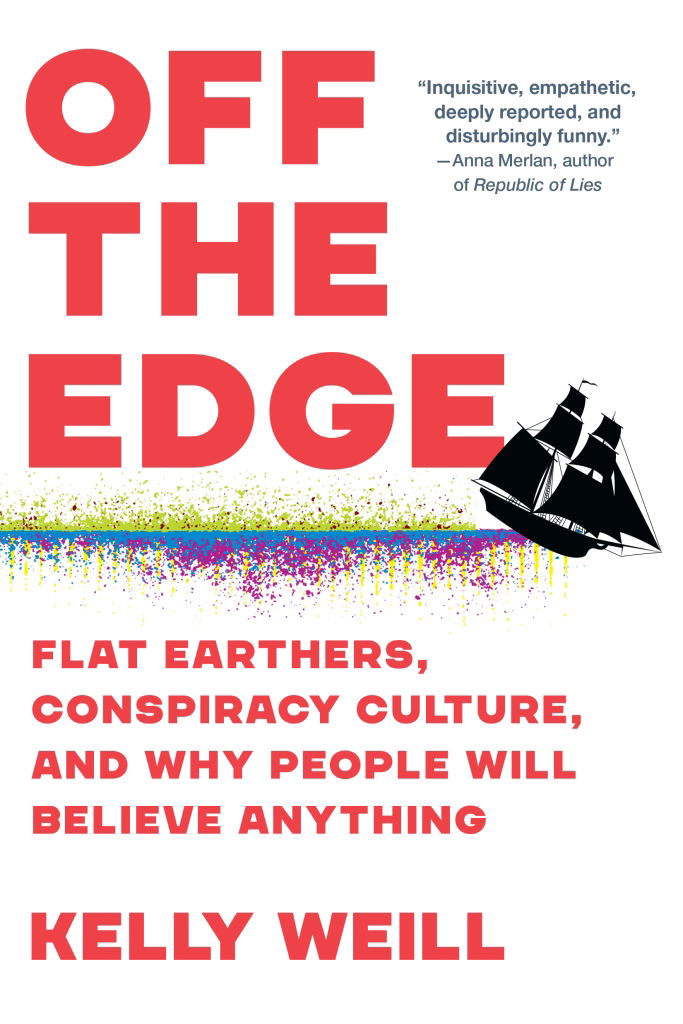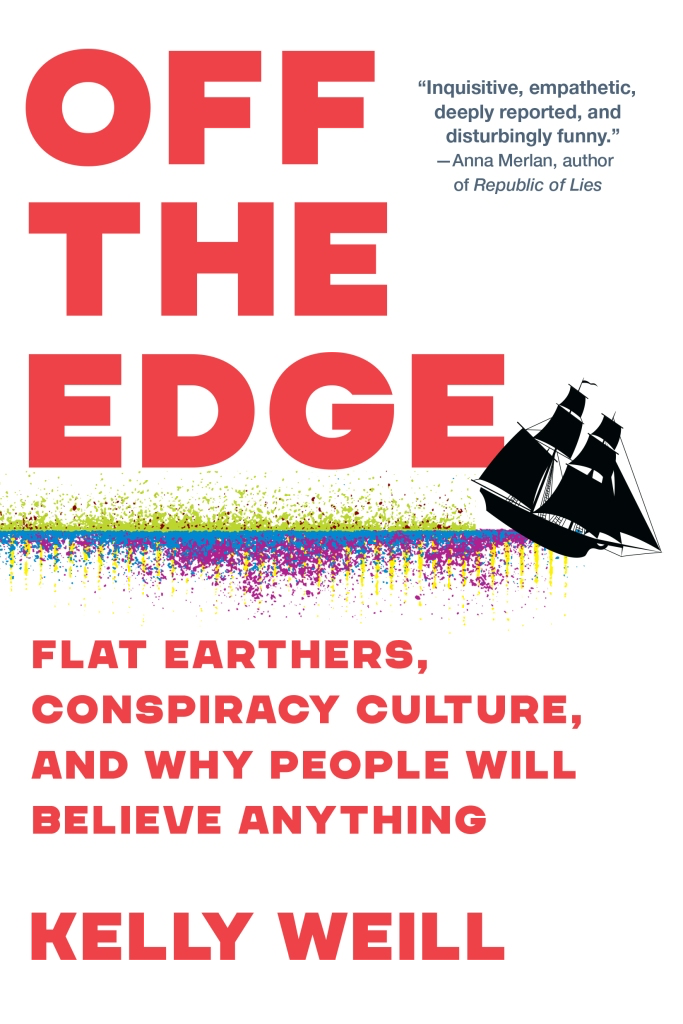Kelly Weill: Off The Edge - Flat Earthers, Conspiracy Culture, and Why People Will Believe Anything


Kelly Weill, Flat Earthers, Conspiracy Culture, and Why People Will Believe Anything (Algonquin Books of Chapel Hill, 2022)
Anybody who has spent any time at all on Twitter or Breitbart—or the comments section following a political piece found on the New York Times, Yahoo, or The Hill websites will be quite familiar with the extremely wide variety of inconsistent ideas that people are absolutely sure are true. It’s not just that some folks believe—contrary to everything we have learned in school and seen on TV or the movies—that the Earth is flat or that the Holocaust never happened or that many Democrats are lizard people who answer only to George Soros. It’s that proponents are so positive of all these things that they are very quick to make fun of anybody who expresses any doubts. True believers think skeptics are hilarious, fools who it is hardly worth the breath it would take to correct their elementary, laughable errors. I expect that most readers of this review feel much the same about the Flat Earthers and QAnon, lizard people proponents. They will simply shake their heads at the fact that some people can’t even be talked to, because when those crazies began their descents down one or another rabbit hole, they left all residue of rationality behind them.
What can we do when everybody is absolutely sure, but there are so many stark disagreements? As far back as the 17th Century, the search for a “mark of true ideas” was something of a holy grail for rationalist philosophers like Descartes and Spinoza. Back then, too, the fact that people believed so many different, incompatible things caused those thinkers to wonder: Is there an absolutely foolproof method of determining when we are right about something? Descartes argued that all and only “clear and distinct” ideas are infallible. On his view, such ideas as that I exist or that 2 + 3 = 5, once understood, display their truth and simply cannot be false. Spinoza, whose writings on this subject in his early Treatise on the Emendation of the Intellect are more confusing, seems somehow to have tied true ideas to the grasping of essences. Scholars still disagree about exactly what he was getting at, but he was quite clear that we can’t be assured of our correctness in any instance in which our views have relied on the claims of others—no matter how apparently authoritative those others are. If we are ever to be sure of something, we need to find it out for ourselves.
In her fascinating history of the Flat Earth movement and other apparently cracked views, Kelly Weill, a chronicler of conspiracy theories and cultists for Daily Beast, notes that the original founder of the Flat Earth sect, one Samuel Birley Rowbotham (1816-1884) was—besides being an argumentative huckster—a believer in so-called “zetetic” science. Whatever else it may imply, that obscurely named method of inquiry coheres with Spinoza’s insistence that nothing should be taken purely on trust: every ostensible fact must be personally experienced in order to be worthy of belief. So, Rowbotham insisted, when determining the shape of the Earth, one should throw away one’s text books and rely exclusively on the evidence of one’s own senses. That was the main moral of his Zetetic Astronomy: Earth Not a Globe, a book whose first edition (1849) barely made for a slim pamphlet, but whose third and final edition (1881) contained no fewer than 443 pages.
Can devotion to zeteticism really get someone to a disc theory Earth? Will it ensure a soft landing on a view according to which our planet is a dish closed in either by a dome or some (perhaps infinite) expanse of Antarctic ice? After all, as Weill points out, we can see for ourselves when watching a sunset or a boat sail over the horizon that the surface of the Earth is curved. Does that mean that zetetic astronomy ends up supporting a globe theory? No! Here, what is apparently hard, zetetic evidence is simply explained away, as one would the appearance of a bend in a stick halfway immersed in water. It thus turns out that it is really only certain phenomena that the principled zeteticist may rely on. Well, how do we determine what the legitimate pieces of evidence are? Unsurprisingly, it seems that what may be counted as acceptably zetetic phenomena is largely matter of personal leanings.
Consider some non-astronomical areas of disagreement. In the case of the Holocaust, for example, an inclination toward antisemitism seems sufficient to engender a zetetically innocent belief that there was never any mass murder of Jews by Nazis during WWII (even though many of those who make this claim also seem to believe that they would have deserved that fate not only then, but also now in virtue of an allegedly undiminished ability to run the world into the ground. In the case of lizard people, a certain reptilian vibe in conjunction with the suspicion that a particular political party has the temerity to want to take away everybody’s God-given right to amass a personal arms arsenal seems sufficient to prove what DNA tests cannot. However, in the case of Flat Earth, at least according to one apostle, neither a psychological leaning nor a reptilian aura will do the trick: what is required is more “scientific.” Here, nothing less than a personal flight to an altitude high enough to see for oneself that our planet bends down at each edge of our visual field can do the trick.
With that principle in mind, Flat Earther “Mad” Mike Hughes, a sometime race car pit mechanic, a DIY rocket builder, and a daredevil in the Evel Knievel vein, planned to fly to the necessary height and take a look around while parachuting down. Why he couldn’t have done this by parachuting out of somebody else’s more traditional flying machine is not explained, except, I suppose, by the fact that Hughes enjoyed—and made a bit of money off—attention. After all, his goal was a height of 5,000 feet, lower than the average recreational jump. (Sky-divers sometimes drop from as high as 30,000 feet.) Perhaps Hughes thought that his pilot might have tried to fool him by slipping something into his drink or by letting him loose over some place in the world where there is known to be an illusory curve rather than the actual flatness that characterizes the entire planet. In any case, Hughes, with his extremely powerful homemade compressed steam rocket and a couple of second-hand parachutes made his solo investigation and was killed on impact with the Earth, whatever its shape, when pretty much anything that could go wrong with his launch did so.
It's hard not to conclude, while reading Weill’s riveting account of people she has met at various cloud cuckoo conferences, that there is a conspiracy theory type. Those personal similarities seem the main reason for the ever-increasing overlap in numbers among subscribers to an array of positions which themselves seem to have little in common. This shared psychological characteristic mostly consists of a gnawing fear, a suspicion, perhaps even a mild paranoia, that some, perhaps small but nevertheless incredibly powerful group, is secretly pulling all the important world strings in a manner that has made one’s life appreciably worse than it would otherwise be. And hanging out with like-minded folk produces, as one CUNY Prof. told Weill, “a sense of being someone…who is privy to this sort of secret world that other people didn’t know about, an alternate world of knowledge that other people didn’t have access to.” This is natural. Where there is a fear of being taken advantage of by a sinister group of elite sadists, why would there not also be a flailing around for people who will fight the power that be with you—arm-in-arm? It doesn’t matter so much if the folk we fall in with are Flat Earthers or QAnon or John Birchers, or KKK or Maoists or Antifa. So long as they are the real folks, the solid, decent people. The ones who get it. Where we find our own kind, we may also find fellowship as well as protection. These conferences are places where one can find a wholesome and warming love.
Weill introduces us to a couple of “recovering” conspiracists and makes some suggestions regarding how to nurture a progression back to rationality. In keeping with the above ideas of the common genesis of conspiracy discoverers, progress in this area seems to revolve around gentleness and welcome. After all, if the whole process starts with alienation and fear, snarkiness and attack are unlikely to bring anybody back to their senses. Weill quotes a couple of pundits who suggest that the ridicule found in several popular podcasts and documentaries have actually been responsible for large increases in cult memberships.
But, again, what is the “sensible” position to take? What gives one group the right to insist that their position is the rational one and any wildly conflicting views are just wacked? As this is a book review and not a treatise on epistemology, I won’t try to give anything like a complete answer to this question (I mean, supposing I were actually competent to do so). I will just say that I think it’s not enough to imply that the above-noted neediness on the part of conspiracy theorists can alone make their views suspect. That common psychological origin—even if the supposition is quite right—cannot by itself invalidate any position. Rather, the defect seems to me to be found in a stark failure to insist upon coherence with the remainder of one’s life and beliefs. If we depend on flights and microwave ovens and television and telescopes and cell towers and satellites, then it is not allowable throw all that stuff away in order to carve out and insist upon a particular theory that is inconsistent with so much of it, no matter how satisfying we may find that theory.
If the conspiracy theorist is no hermit, but lives in the modern world, it is simply irrational for her to advocate for any position that doesn’t jibe with most of the rest of what keeps that modern world buzzing along. As philosopher Susan Haack has explained, justification for beliefs is much like a crossword puzzle, and it is unacceptable (and generally impossible) to finish such a game when focusing exclusively on across clues—whether or not they happen to produce answers that jibe so nicely with our desires and fears. Weill’s book provides not only a detailed history of Flat Earth theory and its proponents, but also thoughtful (and depressing) accounts of antisemitism and other manias. I was particularly amused by her putting a conspiracy-theory angle on the Y2K panic—partly because I recalled that the fear of airplanes falling from the sky, etc. (simply because of a date change) had also resulted in numerous, presumably rational, buttoned-down insurance companies frantically filing exclusions to their business interruption and property coverages.
Weill’s description of a repeated transition from some “scientific” or political position into (often health-related) grift is also eye-opening. Whether or not Alex Jones was a Flat-Earther, he was also pushing the same sort of useless nutritional supplements to his followers that Rowbotham had urged on his flock over a century earlier. In addition, Weill’s discussion of the effects of YouTube and Facebook profit motives on dissemination of disinformation are thought-provoking and, arguably, quite important. I admit, though, that I myself remain unconvinced of corporate culpability here. No doubt the platforms suggest the nonsense that people want to see and/or those customers want to see what additional nonsense the platforms do suggest for them. But I don’t know to what extent the corporations should be required to “fix” this, particularly if it will not only cost them a lot of revenue, but also make their users unhappy. I understand the problem presented by the garbage-producing algorithms, I’m just not sure what makes sense as a solution. (I note as an aside that YouTube has quite recently made a move with respect to election denial videos that I suspect disturbs me as much as it does Weill.)
Throughout the book, Weill interweaves descriptions of her personal reactions to both the sincere proclamations and the unfortunate problems of the conspiracy theorists she has met—and sometimes befriended. As her surname is Jewish and she has published her thoughts about cultists for some time, she has had to deal with the occasional nasty interaction both in person and on social media. But she has not lost heart. Her writing is trenchant, elegant, and often moving, a combination that resulted in my sometimes finding it hard to believe that she hasn’t yet lived through 30 orbits of our magnificent globe around a certain gigantic flaming orb that somehow manages to hold us all in place, whatever our views may be about the matter.

About the Author
Walter Horn is a philosopher of politics and epistemology.
His 3:16 interview is here.